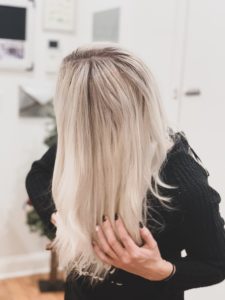What Is Hair Elasticity & Why It’s Important
You probably know what elasticity means (think elastic), but did you know that your hair elasticity can change based on the condition of your hair? In this post I’m going to cover how elasticity relates to your hair and why it’s important. I’ll also mention some tips to help you improve the elasticity of your hair as well as what to avoid.

What is elasticity?
Before diving in to how elasticity relates to hair, let’s first discuss what elasticity is. Elasticity refers to an objects ability to return to its regular state after being stretched out. Think of a bungee cord that stretches and then returns back to normal.
A bungee cord has high elasticity because it can stretch 100%+ and then return to normal. An object with low elasticity will either not stretch at all, will break when stretched, or will stretch and not return to its normal state.
Why is hair elasticity important?
When it comes to hair, you want it to stretch and return to normal similarly to a bungee cord. The difference is that a bungee cord will stretch 100% of its length, and hair should only stretch a maximum of 50% of its length. This means that healthy hair should have medium elasticity.
Damaged hair has a low elasticity because it will either break when stretched, or will stay stretched out like bubble gum without returning to its normal state.
What causes poor hair elasticity?
There are a number of different factors that can cause poor hair elasticity. The most common causes are from over-processing with chemical services (bleaching, perming, and relaxing) as well as heat damage from flat and curling irons turned too hot without a thermal protectant.
When hair is over-processed to the point where the elasticity is heavily affected, you’ll likely know. I’ve seen hair in the salon turn to a bubblegum-like consistency. This is usually due to bleaching the hair more than it can handle. The hair stretches without returning, breaks off, and feels limp. When box color is used at home and then bleached to remove, this is a common side-affect.
Some other causes are lack of moisture, a protein deficiency, or build-up on the hair from either cheap hair products or minerals in hard water.
How do you know your hair elasticity?
On average your hair should stretch 30-50% of its original length when wet, and only 20% when dry. The best way to test your hair elasticity is when it’s wet with one strand at a time. Follow my hair elasticity test below.
Hair elasticity test
- Wet the hair you want to test
- Select only one strand of hair
- Hold one end of the hair securely with your pointer finger and thumb
- Grab the other end of the strand and begin to stretch and release it
- If the hair stretches and returns to its original length, the elasticity is good
- If the hair breaks or stays stretched out, the elasticity is poor and the hair is likely damaged
How to improve your hair elasticity
If after completing the test you determine that your hair has poor elasticity, there are measures you’ll need to take to make sure that you stop causing more damage, and heal the hair as much as possible.
Below I cover habits as well as my product recommendation to improve your hair elasticity.
To learn more about how to make your hair healthy again, see my post here.
***Since I’m sharing the products that I love to use with you guys, this page includes affiliate links to these products. If you take action and purchase a product through clicking one of my links, I’ll make some commission money from it at no extra cost to you. This enables me to be able to continue giving you awesome hair tips, so thanks! ***

Habits to heal your hair:
- Avoid washing more than every 4 days
- Avoid heat tools
- Use thermal protection if you do use heat tools
- Turn your iron temperature way down
- Cover your hair from the sun and tanning beds
- Don’t get your hair wet in the ocean or pools
- Avoid rough towel drying and towel turbans
- Avoid messy buns, high pony tails, and tight elastic rubber bands
- Be extremely careful when brushing, starting from the bottom
- Use a boar bristle brush to detangle dry hair
- Use a nylon brush to detangle wet hair
- Regularly trim your hair to avoid breakage off of the ends
- Avoid bleaching your hair
- Consider getting a keratin treatment (protein treatment)
- Follow my product routine recommendations below
Product recommendations:
First, alternate between a bond building shampoo and conditioner, with a moisturizing or repairing shampoo and conditioner.
- Olaplex no. 4 & no. 5 – Bond building shampoo and conditioner
- Pravana Intense Therapy Shampoo and Conditioner – Repairing shampoo and conditioner
- Aquage Silkening Oil Shampoo and Conditioner – Moisturizing & smoothing shampoo and conditioner
Next you’ll want to alternate between a bonding treatment and a moisturizing treatment. For extremely damaged hair, I recommend doing a treatment every time you wash your hair.
- Olaplex no. 3 – Bond building treatment. This is to be applied before you shampoo and condition.
- Olaplex no. 8 – Moisturizing treatment. This can be done after your regular conditioner
- Pravana Intense Therapy Treatment – Repairing treatment, can be done after you shampoo and condition.
After your shower, you’ll want to use a number of leave-in products. This step is as important as moisturizing your face after washing it! For highly damaged hair, I recommend using a leave-in conditioner as well as a hair serum.
- Olaplex no. 6 – Bond building leave-in conditioner
- Olaplex no. 9 – Bond building serum
- Pravana Intense Therapy Leave-in – Repairing leave-in conditoner
- Aquage Silkening Oil Treatment – Silkening leave-in serum
After your hair is dry, you can use a dry conditioner to smooth your cuticle down. You should also use a thermal protection spray if you are going to iron your hair.
- Aquage Beyond Shine – Thermal spray that adds shine
- Kenra Dry Conditioning Mist – Dry conditioner to smooth dry hair
Conclusion
Elasticity refers to an objects ability to be stretched and returned to its normal state. If an object has high elasticity it will stretch over 50% of its length and then go right back to normal. If an object has low elasticity it will either not stretch at all, will stretch and break off, or will stay stretched without returning to its original state.
Healthy hair should be of a medium elasticity. This means it can stretch about 20% when dry, and 30-50% when wet. Poor elasticity is caused by over-processing from chemical services, heat tools, and build-up.
You can test your hair elasticity by stretching a strand of hair when it’s wet and seeing how it responds. Follow my above habits and product recommendations to improve poor hair elasticity.
For any further questions on this topic, leave them for me in the comments! If you found this post helpful, you’ll likely enjoy this one here on hair porosity.
As always, have a good hair day!


